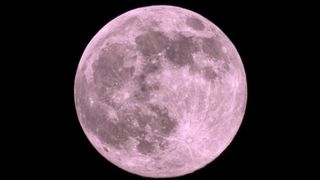Watch the full 'Pink Moon' rise into the sky on April 6
April 2023's full moon is known as the Pink Moon and the Paschal Moon. It will be at its fullest at 12:34 a.m. EDT on Thursday, April 6, 2023.

This month's full moon, known as the Pink Moon, will be at its fullest on Thursday, April 6, 2023, and will shine close to the bright star Spica. The moon will also appear bright and full on Wednesday and Friday.
According to Timeanddate.com (opens in new tab), April's full moon is called the Pink Moon after the pink phlox wildflowers that are native to North America and often bloom in April. Other names for April's full moon include the Breaking Ice Moon, Budding Moon, Awakening Moon and Egg Moon. Many Anishinaabeg, or Ojibwe, Indigenous people of the Great Lakes region know it as Popogami Giizis, or Broken Snowshoe Moon, according to the Center for Native American Studies (opens in new tab).
Related: What is the moon phase today?
This month's full moon also gets the name Pesach or Passover Moon, as well as Paschal Moon for its associations with religious festivals. The Jewish festival Pesach or Passover begins at sunset on Wednesday, April 5, and ends at nightfall on Thursday, April 13, 2023.

If you want to get a detailed look at Pink Moon, we'd recommend picking up a telescope. Our top pick for people getting into skywatching is the Celestron Astro Fi 102 (opens in new tab). Check out our full review, and see how it stacks up in our best telescopes guide.
Meanwhile, the date of the Paschal Moon is how the date of Easter is calculated, as Easter is held on the first Sunday after the first full moon of spring. Western Christianity will be celebrating Easter on Sunday, April 9, 2023 — the Sunday after the Pink Moon. According to NASA (opens in new tab), Eastern Orthodox Easter will be a week later on Sunday, April 16.
In the Hindu lunisolar calendar (a combination of the lunar and solar calendars), this full moon marks the Hanuman Jayanti festival, while for Buddhists in Sri Lanka, it's Bak Poya.
The best time to watch the full moon rise in the east will be Thursday, April 6, when it will rise shortly after sunset. Check the times of moonrise and moonset for your location (opens in new tab) and find a place to observe from that has a low view of the eastern horizon.
Spica, the bright star in the constellation Virgo,will be about 8 degrees to the lower left of the Pink Moon on the night the moon is fullest according to NASA. The following night, Friday, April 7, will see the waning gibbous moon just 3 degrees from Spica.
A rising and setting full moon looks orange when it's seen close to the horizon because of Rayleigh scattering. The light from the moon has to travel through more of Earth's atmosphere to reach the observer. That means the shorter wavelengths of blue light are scattered as they strike molecules in the atmosphere, while longer-wavelength reddish and orange light more easily passes through. Rayleigh scattering is also why the sky is blue and sunrises and sunsets are reddish.
After the Pink Moon, the next full moon will occur on May 5. This Flower Moon, also called the Corn Planting Moon and Milk Moon, will move into Earth's outer shadow in space to cause a penumbral lunar eclipse.
If you're looking to get into skywatching and astronomy, we've got plenty of guides to help you get started. If you're wanting to view the night sky then our best binoculars for stargazing (opens in new tab) and best telescopes (opens in new tab) guides have you covered, while the best astrophotography cameras (opens in new tab) will let you capture those spectacular views for others to enjoy.
Live Science newsletter
Stay up to date on the latest science news by signing up for our Essentials newsletter.
Jamie Carter is a freelance journalist and regular Live Science contributor based in Cardiff, U.K. He is the author of A Stargazing Program For Beginners (opens in new tab) and lectures on astronomy and the natural world. Jamie regularly writes for Space.com, TechRadar.com, Forbes Science, BBC Wildlife magazine and Scientific American, and many others. He edits WhenIsTheNextEclipse.com (opens in new tab).
Most Popular

By Harry Baker